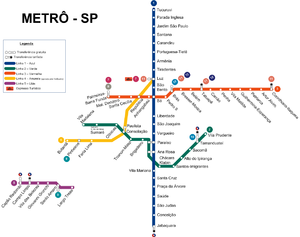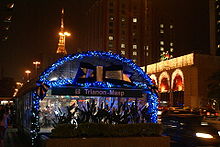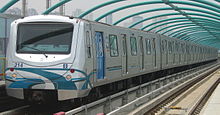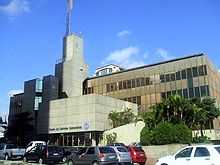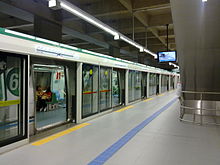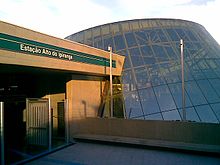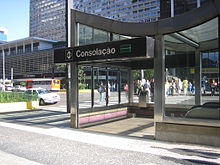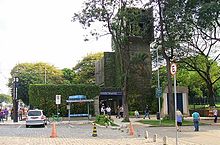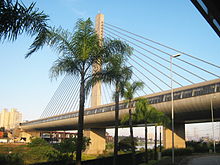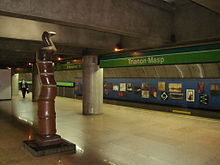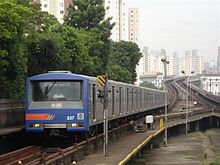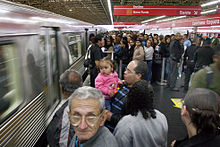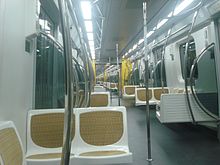- São Paulo Metro
-
São Paulo Metro 
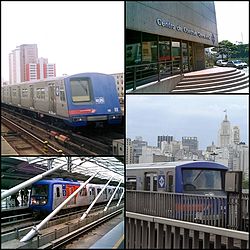
Info Locale São Paulo Transit type Rapid transit Number of lines 5 (Lines 4 and 5 in expansion) Number of stations 62 Daily ridership 3,600,000 (FY 2010) Operation Began operation September 14, 1974 Operator(s) Companhia do Metropolitano de São Paulo (Lines 1, 2, 3, 5)
ViaQuatro (Line 4)Technical System map The São Paulo Metro (Portuguese: Metropolitano de São Paulo, commonly called Metrô) is the principal rapid-transit system in the city of São Paulo and the largest in Brazil. It is also the second largest system in South America and the third largest in Latin America, behind Mexico City and Santiago.
The Companhia do Metropolitano de São Paulo - Metro was founded on 24 April 1968. Eight months later, work on North-South line was initiated. In 1972, the first train trip occurred between Jabaquara and Saúde stations. In 1974, the segment between Jabaquara and Vila Mariana entered into commercial operation.
Today, São Paulo Metro is considered the best rail transportation system in the Americas.[1][2][3] The Metro has a length of 74.3 kilometres (46.2 mi), distributed into five lines with 64 stations.
The system is interlinked with CPTM (São Paulo Metropolitan Trains Company) at Brás, Palmeiras-Barra Funda, Tatuapé, Corinthians-Itaquera, Tamanduateí and Santo Amaro stations, and at other modal transportation terminals in the city of São Paulo.[4][dead link]
Contents
Lines
The metro system consists of five color-coded lines: Line 1 (Blue), Line 2 (Green), and Line 3 (Red) which operate every day, including Saturday, Sunday, and holidays; Line 4 (Yellow) currently operating from Monday to Saturday, from 4:40 AM to midnight and Line 5 (Lilac) operating from Sunday to Saturday, from 4:40 AM to midnight. The metro system carries 3,600,000 passengers a day (two million by entering directly into the system and the remainder by free integration with CPTM and paid integration with the municipal bus system). Metro itself is far from covering the entire urban area in the city of São Paulo and only runs within the city limits. Another company, Companhia Paulista de Trens Metropolitanos (CPTM), serves 22 of the 39 municipalities that make up the São Paulo Metropolitan Region with commuter lines, which total six lines (7, 8, 9, 10, 11 and 12), 260.8 kilometres (162.1 mi) long, serving 93 stations and carrying 2,100,000 passengers a day. Metro and CPTM are integrated through various stations. Metro and CPTM both operate as State-owned companies, and have received awards in the recent past as one of the cleanest systems in the world by ISO9001.
The first line, Norte/Sul (North/South), later renamed "blue line" or Line 1 Blue, was opened on September 18, 1972, with an experimental operation between Saúde and Jabaquara stations. Commercial operations started on September 14, 1974, after an eight-year "gestation" period that began in 1966, under mayor Faria Lima's administration. Expansion of the metro system includes new lines. As of late 2004, construction began on a US$ 1 billion, 12.8 km (7.9 mi) all-underground line (Line 4 Yellow), with eleven stations, aimed at transporting almost one million people per day. By 2004, line 2 was also being expanded, with two new stations open in 2006 and another one in 2007.
An 11.4 km (7 mi) expansion of Line 5 and construction of a 28 km (17.3 mi) International Airport express line are in the pipeline as well. Plans also include updating the CPTM heavy rail system, which will add several million passengers capacity into the system. It is expected that the São Paulo Metro and CPTM systems will carry about 7 million people on average week days by 2014, as opposed to today's 5.3 million (Metro: 3.3 million; CPTM: 2 million as of 2009). Metro stations operate from 4:40 AM to around 12:00 AM. As of February 2011[update], tickets cost R$ 2.90. In 2006, the São Paulo Metro system has started to use a smart card, called "Bilhete Único" (or "Single Ticket" in English), allowing a passenger to take up to 4 buses and 1 metro or suburban train within 2 hours paying only R$ 4.07, 4 buses paying R$ 2.70 or metro or a suburban train within 3 hours only and pay R$ 4.07.
Line 1 - Blue
Main article: Line 1 (São Paulo Metro)Line 2 - Green
Main article: Line 2 (São Paulo Metro)Line 3 - Red
Main article: Line 3 (São Paulo Metro)Line 4 - Yellow
Main article: Line 4 (São Paulo Metro)Line 5 - Lilac
Main article: Line 5 (São Paulo Metro)Line 6 - Orange
Main article: Line 6 (São Paulo Metro)Service
The São Paulo Metro aims at keeping the state-of-the-art technology, updating itself constantly, assimilating and dominating new constructive, operating, and management techniques. Accordingly, in 1999 Metro began work to conform to the international quality management standards, specifically the series of ISO 9000 standards. The first certification was obtained on November 21, 2000, that of the Rolling Stock Maintenance Process of Lines 1 Blue, 2 Green and 3 Red.
Upon the implementation of the quality management system in the operation services, the São Paulo Metro became the second in the world to have all lines certified by standard NBR ISO 9001, version 2000. The first was the Hong Kong Metro.[5]
Upon the implementation of an Occupational Health and Safety Management System, certified in December 2006, the São Paulo Metro became the first metro-railway transport company in the country to achieve such certification. This system gives the company a management structure for safety and health issues focused on preventive actions, comprising all employees, outsourced personnel and visitors.[6]
Metro station art
Metro Station on Paulista Avenue.
The Cultural Action Program began in the seventies and was officially authorized in 1986, being characterized by artistic and cultural transitory actions whose purpose was to add quality to Metro's relationship with its users and with the cultural agenda of the city. As the Metro stations are a gathering place of a significant part of the city's population, they also offer a proper stage for many cultural activities, from thematic and art exhibitions to musical and theater performances, composing a monthly agenda that is already considered part of the city's cultural life.
One of the projects that marked the history of the Cultural Action Program of São Paulo Metro, is the University Art project that brought the musical and theatrical talent of university students to the stations. Another is the Itaú Metrô Musical Wednesday, which was sponsored in partnership with the Itaú Bank and brought important representatives of Brazilian music to the São Bento Metro Stations on Wednesdays at lunchtime.
All of these actions are planned to provide information and culture in addition to entertainment. Some of the extensive performances within the Cultural Action Program that occurred recently are noted below:
Project Travel to the Movies
A partnership with the Board of Cinema of the State of São Paulo enabled the São Paulo Metro to implement a project to foster the Brazilian cinema. Is the "Travel to the Movies," which started in April 2004 with the movie "Benjamin." The project operates as follows: a theme exhibition about the movie is organized in a certain station and the users, after visiting it, take part of promotions that give tickets to watch the movie.
The São Paulo Metro traditionally promotes several art activities and manifestations in its stations. This specific initiative is part of its strategy of relationship with the users and the society. This is the kind of action that valorize the quotidian life of the people that use such transport mode, adding culture to the provided service and allowing several forms of art and cultural expression to reach a large audience.
The project "Travel to the Movies" is in compliance with this policy, opening the cultural agenda of Metro for the Brazilian cinema and offering a promotion to the users, besides fostering the use of the system for leisure reasons, since the majority of the playing rooms are close to the stations. Some movies that have already participated to the Trip to the Cinema are: "Olga," "Nina," "Contra Todos," "Jogo Subterrâneo," "Cabra-Cega" e "Mais Uma Vez Amor." "O Coronel e o Lobisomem," "Quanto Vale ou é por Quilo," "Se eu Fosse Você," "Mulheres do Brasil." "Boleiros 2" and "Tapete Vermelho", among others.
The Subways of the World in São Paulo Metro
Sculpture and Picture in SP Metro.
This project was initiated on the 8th of November 2000 and had the objective of establishing thematic spaces for the exhibition of other subway systems, in order to provide information about these systems and access to the culture of the origin countries for the user. The subway chosen was the Parisian subway in honor of its centennial. The exhibition was sponsored by Alstom and Bank of Brazil, and remained at the Paraíso station until the November 13, 2001. The space imitated a Parisian square with a typical French boulangérie. More than 60 artistic features referring to French culture were presented, such as Can-Can dancers, burlesques, mime shows, marionette shows, and singers, among others, averaging four features per month. There also was an exhibition room of approximately 120 square metres (1,300 sq ft), reproducing the entrance of the Métropolitain station, where the Parisian subway with scale models, network maps, consumption goods with the trade mark RATP, objects used at the stations, etc. was represented. The exhibition was visited by more than 200 thousand people, and in one single show some 2,700 spectators were registered.
One cannot speak about the Cultural Action Program without mentioning the already traditional Christmas Carol Choir, whose presentations are part of the city's culture. Every year, during the month of December, the population has the opportunity to hear several choirs singing Christmas music in different stations, transmitting Christmas cheer and best wishes on behalf of the São Paulo Metro.[7]
Project Voices and Glances from Brazil
This project was accomplished in partnership with the 5th Centennial Association of Brazil, in São Paulo, and sponsored by Eletropaulo for Brazil's 500 year discovery celebration. During nearly one year an extensive artistic and educational program was offered in the stations and the theme was the discovery of Brazil and its cultural roots. Within this program it was possible to attend a presentation of Guarani songs and dances named Nãndé Baraeté that were presented in several stations of the system. Recitals of the guitar group Camerata de Violões of the Tom Jobim Free University of Music. As well as to listen to story tellers, and visit the São Paulo on the Tracks of Time exhibition, which told the story of the Brás, Liberdade and Itaquera city districts that was transmitted through the oral traditions of the residents and carefully researched by the Person Museum.
Current operational data
Its current extension does not cover all the areas in the city, however, the subway network, with five lines (three of which are undergoing construction for extensions), is complemented by a network of metropolitan trains of 260.8 km (162 mi), divided into six lines operated by CPTM, which serve the capital and other cities in the Greater São Paulo, extending up to Jundiaí, Guarulhos, Osasco, Diadema, Santo André, Mogi das Cruzes, Ferraz de Vasconcelos, and others.[8] The metro is funded by the São Paulo government and is run by a special self administered organisation. In terms of service the lines are generally average compared to international standards although certain more prominent lines and station such as the yellow line and the downtown stations are feature much more capable infrastructure due to their expected high use and run much more quickly and efficiently while less used lines are historically given less attention and usually run a lesser number of cars. The São Paulo government has began to address this issue and is currently building more lines and stations in farther out areas and ordering more cars to run on lines already in service with the increase in funding th São Paulo government has been receiving in recent years due to the growth of th Brazilian economy.
Conversion of metropolitan lines to surface metro
This project of conversion of lines to metro arose due to the high demand of passengers who use the metropolitan lines of CPTM and the need to recover the old stations.
Currently, the interval between trains goes up to thirty minutes on weekends, and yet there are old nineteenth century stations that were never modernized. With the extreme need to recover stations, it appeared that the plan of conversion, which is nothing but the modernization of the stations, purchase of new trains and reduction of headway to less than three minutes, as international standards.
Between the end of the 1990s and the early 2000s, with this project of refurbishing the CPTM lines, inherited from the RFFSA, Federal Railway Network and Fepasa (former São Paulo State Railways), the conversion of some metropolitan lines to the Metro standard began. This experience started in Line E, in the stretch known as "Eastern Express," serving Eastern São Paulo and running parallel to Line 3-Red. The stretch completed (to Guaianases station) today has new and modern trains and stations with a new route in the final part. The next stretch to be built, between the station Guaianases, in the Capital, and Estudantes in Mogi das Cruzes, also covering the cities of Ferraz de Vasconcelos, Suzano and Poá, is estimated to have its works resumed in 2007, but this was again postponed, now to 2008. Currently, Line 9 (Emerald) and Line 11 (Coral) - "Expresso Leste" ("Eastern Express") are the only CPTM lines to have been converted to full Metro.
Bus terminals
In May 1977, Metro assumed the administration and commercial utilization of the Inter-City Jabaquara Intermunicipal Terminal, and inaugurated, in May 1982, the modern Inter-city Tietê Bus Terminal, replacing the former Júlio Prestes Terminal.
This agreement established that Metro would be in charge of the studies for the planning, implementation, and operation of passenger transportation in the municipal district of São Paulo, either directly or through third parties.
Later, the other inter-city bus terminals were integrated into the system, such as Bresser, in January 1988, and Palmeiras-Barra Funda, in December 1989. In January 1990 the inter-city bus terminals were outsourced by Metrô, which through public bidding, contracted Consortium Prima for the administration and commercial utilization of the 4 inter-city bus terminals of the city of São Paulo. This contract included the responsibility for maintenance and conservation of the existing installations, as well as of the expansion and modernization of the terminals.[9]
Security
Metro's security agents have police powers and in case of need they will provide assistance. All police matters that occur within the system are directed to the police station of the subway system, DELPOM (Delegacia de Polícia do Metropolitano de São Paulo), located at Palmeiras-Barra Funda station.[10]
System lines
Line Color Termini Opened Length Stations Duration of trips (min) Hours of Operation Line 1 Blue Tucuruvi ↔ Jabaquara September 14, 1974 20.2 kilometres (12.6 mi) 23 45 Daily, from 4:40 AM to 0:32 AM Line 2 Green Vila Madalena ↔ Vila Prudente January 25, 1991 14.6 kilometres (9.1 mi) 14 18 Daily, from 4:40 AM to 0:20 AM Line 3 Red Palmeiras-Barra Funda ↔ Corinthians-Itaquera March 10, 1979 22 kilometres (14 mi) 18 36 Daily, from 4:40 AM to 0:35 AM Line 4[11] Yellow Vila Sônia ↔ Luz May 25, 2010 12.8 kilometres (8.0 mi) 11 2 Daily, from 4:40 AM to 0:00 AM Line 5 Lilac Capão Redondo ↔ Largo Treze October 20, 2002 8.4 kilometres (5.2 mi) 6 11 Daily, from 4:40 AM to 0:00 AM Future developments
New lines are planned. In September 2010, CMSP awarded contracts for the construction of a 23.8 kilometres (14.8 mi) long monorail with 17 stations, which would effectively extend Line 2 (Green) from Vila Prudente through São Mateus and Cidade Tiradentes.[12]
Extensions
Extension for Color Termini Opened Length Stations Line 2-A[13] Green (Monorail) Vila Prudente ↔ Cidade Tiradentes Under construction 23.8 kilometres (14.8 mi) 17 Line 4[14] Yellow Taboão da Serra ↔ Vila Sônia Under project 2 kilometres (1.2 mi) 2 Line 5[15] Lilac Largo Treze ↔ Chácara Klabin Under construction 11.4 kilometres (7.1 mi) 11 Projects
Line Color Termini Length Stations Line 6[16] Orange Brasilândia ↔ São Joaquim 14 kilometres (8.7 mi) 17 Line 15[17] White Vila Prudente ↔ Tiquatira 10 kilometres (6.2 mi) 9 Line 16[18] Silver (Monorail) Cachoeirinha ↔ Lapa 9 kilometres (5.6 mi) 10 Line 17[19] Gold (Monorail) São Paulo - Morumbi ↔ Congonhas / Jabaquara 21.5 kilometres (13.4 mi) 20 Line 18[20] Brown (Monorail) Tamanduateí ↔ Alvarengas 20 kilometres (12 mi) 18 Line 19[21] Sky Blue CECAP ↔ Água Espraiada Line 20[22] Pink Lapa ↔ Moema See also
- List of São Paulo Metro stations
- Transport in São Paulo
- List of rapid transit systems
- Companhia Paulista de Trens Metropolitanos - São Paulo's Metropolitan Train Company
References
- ^ MetroRail announced in 2010 on the SP Metro choice as the best of America, in London
- ^ Metros award 2010
- ^ Publication of the award in the site ExpansãoSP-Metrô
- ^ Expansion
- ^ Quality of São Paulo Metro
- ^ São Paulo Metro and Occupational Health and Safety Management System
- ^ Culture and Art of São Paulo Metro
- ^ Metropolitan Map of São Paulo
- ^ Bus Terminals - São Paulo Metro
- ^ Security in São Paulo Metro
- ^ http://www.expansao.sp.gov.br/metro_linha_amarela.php
- ^ "Railway Gazette: São Paulo awards monorail metro contract". http://www.railwaygazette.com/nc/news/single-view/view/sao-paulo-awards-monorail-metro-contract.html. Retrieved 2010-09-28.
- ^ http://www.metro.sp.gov.br/aplicacoes/news/tenoticiasview.asp?id=65655766AE&categoria=6561F2&idioma=PO
- ^ http://www.expansao.sp.gov.br/metro_linha_amarela.php
- ^ http://www.expansao.sp.gov.br/metro_linha_lilas.php
- ^ http://www.expansao.sp.gov.br/metro_linha_laranja.php
- ^ http://www.expansao.sp.gov.br/metro_linha_branca.php
- ^ http://www.expansao.sp.gov.br/metro_linha_prata.php
- ^ http://www.expansao.sp.gov.br/metro_linha_ouro.php
- ^ [http://www.aeamesp.org.br/bblt/16s/d4programa.aspx Associação dos Engenheiros e Arquitetos do Metrô de S. Paulo - 16ª Semana da Tecnologia Metroferroviária - 16 de setembro de 2010, Palestra : Metroleve ABC-SP
- ^ [http://www.domboscoitaquera.org.br/downloads/secretaria_estadual_de_transportes.pdf Seminário sobre infraestrutura e sistema viário para a copa 2014 e o desenvolvimento da zona leste, Jurandir Fernandes, Secretário dos Transportes Metropolitanos, 25/08/2011
- ^ [http://www.domboscoitaquera.org.br/downloads/secretaria_estadual_de_transportes.pdf Seminário sobre infraestrutura e sistema viário para a copa 2014 e o desenvolvimento da zona leste, Jurandir Fernandes, Secretário dos Transportes Metropolitanos, 25/08/2011
External links
- (English) São Paulo Metro website
- (Portuguese) Metro Expansion project website
- (Portuguese) State Transport Secretariat website
- (Portuguese) Find places near the subway stations
- (Portuguese) Essential Network of São Paulo Metro (project of extension of the network to be ready by 2025)
- (English) CityMayors article
● Line 2 (Green) ● Vila Madalena · Santuário Nossa Senhora de Fátima-Sumaré · Clínicas · Consolação · Trianon-Masp · Brigadeiro · Paraíso · Ana Rosa · Chácara Klabin · Santos-Imigrantes · Alto do Ipiranga · Sacomã · Tamanduateí · Vila Prudente● Line 3 (Red) ● Palmeiras-Barra Funda · Marechal Deodoro · Santa Cecília · República · Anhangabaú · Sé · Pedro II · Brás · Bresser-Mooca · Belém · Tatuapé · Carrão · Penha · Vila Matilde · Guilhermina-Esperança · Patriarca · Artur Alvim · Corinthians-Itaquera● Line 4 (Yellow) ● Luz · República · Higienópolis-Mackenzie · Paulista · Oscar Freire · Fradique Coutinho · Faria Lima · Pinheiros · Butantã · São Paulo-Morumbi · Vila Sônia● Line 5 (Lilac) ● Capão Redondo · Campo Limpo · Vila das Belezas · Giovanni Gronchi · Santo Amaro · Largo Treze · Adolfo Pinheiro · Alto da Boa Vista · Borba Gato · Brooklin-Campo Belo · Água Espraiada · Ibirapuera · Moema · Hospital Servidor Público · Vila Clementino · Santa Cruz · Chácara Klabin● Line 6 (Orange) ● Brasilândia · Vila Cardoso · Itaberaba · João Paulo I · Freguesia do Ó · Santa Marina · Água Branca · Pompéia · Perdizes · Cardoso de Almeida · Angélica · Higienópolis-Mackenzie · Treze de Maio · São JoaquimItalics indicates planned stations. Bold indicates stations being constructed.Commuter Rail Line 7 (Ruby) • Line 8 (Diamond) • Line 9 (Emerald) • Line 10 (Turquoise) • Line 11 (Coral) • Line 12 (Sapphire) • Line 13 (Jade) • Line 14 (Onyx)
Metro
(List of stations)Line 1 (Blue) • Line 2 (Green) • Line 3 (Red) • Line 4 (Yellow) • Line 5 (Lilac) • Line 6 (Orange) • Line 15 (White) • Line 16 (Silver) • Line 17 (Gold)Bus Lines SPTrans • Empresa Metropolitana de Transportes Urbanos de São Paulo (EMTU) • Expresso Tiradentes • Trolleybuses in São PauloAirports Bus Terminals Tietê Bus Terminal • Jabaquara Intermunicipal Terminal • Lapa TerminalIntermodal Terminals Sacomã Terminal • Luz Station • Palmeiras-Barra Funda Terminal Urban public transport networks and systems in Brazil
Urban public transport networks and systems in BrazilMetropolitan area
commuter railJoão Pessoa • Maceió • Natal • Rio de Janeiro • Salvador • São Paulo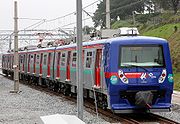
Rapid transit Belo Horizonte • Brasília • Fortaleza* • Porto Alegre • Recife • Rio de Janeiro • Salvador* • São Paulo • TeresinaLight rail Arapiraca Metro* • Brasília Light Rail* • Cariri Metro • Macaé Light Rail* • Maceió Light Rail* • Recife Light Rail*Monorail Manaus* • São Paulo*Trolleybuses Santos • São Paulo(*) Under ConstructionCategories:- Rapid transit in Brazil
- Electric railways in Brazil
- Underground rapid transit in Brazil
- Transport in São Paulo (city)
Wikimedia Foundation. 2010.

